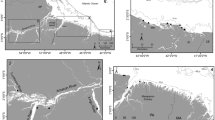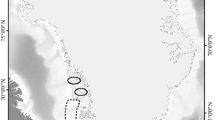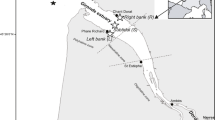Abstract
The trophic dynamics of islands with low terrestrial primary productivity often depend on marine allochthonous inputs from nearby donor habitats. For instance, on Malpelo Island, Colombia (4° 00′ 05.63″ N; 81° 36′ 36.41″ W), the Nazca booby Sula granti affects the productivity and trophic dynamics of the terrestrial ecosystem by delivering nutrients, primary in the form guano, chick carcasses, and eggs. This study evaluated the trophic connectivity between the terrestrial and marine ecosystems of Malpelo Island, Colombia based on the isotopic (δ13C and δ15N) assessment of 403 samples (107 terrestrial and 296 marine) collected between 2017 and 2021. Isospaces were estimated based on δ13C and δ15N values, contribution of terrestrial sources in consumer diets (mixing model), 15 N enrichment in C3 plants, and interactions among environments (overlap). δ13C and δ15N values showed a larger terrestrial isospace (134.7‰2) than the marine isospace (117.2‰2). The mixing model indicated that detritusTerrestrial (median: 30.2%) contributed more to the food web than C3 plants (0.2%), reflecting high δ13CMarine content. The high isotopic overlap (> 60%) between terrestrial and marine isospaces suggests a significant trophic connection between environments. These results show the role of the marine ecosystem on the terrestrial ecosystem and the importance of S. granti regarding nutrient transfer between environments. The conservation of this seabird is essential to maintain the balance of this insular ecosystem. Using stable isotopes, this study was able to reveal trophic relationships between ecosystems associated with small oceanic islands that host large seabird colonies but have low primary productivity.








Similar content being viewed by others
Availability of data and material
All data produced in this study are provided in this manuscript.
References
Amundson R, Austin AT, Schuur EA, Yoo K, Matzek V, Kendall C, Uebersax A, Brenner D, Baisden WT (2003) Global patterns of the isotopic composition of soil and plant nitrogen. Glob Biogeochem Cycles 17(1):1031. https://doi.org/10.1029/2002GB001903
Anderson WB, Polis GA (1999) Nutrient fluxes from water to land: seabirds affect plant nutrient status on Gulf of California islands. Oecologia 118:324–332. https://doi.org/10.1007/s004420050733
Bach de Roca C, Molero-Baltanás R, Guju-Ricart M (2015) Clase insecta: orden microcoryphia. Ibero Diversidad Entomológica 38:1–12
Barret K, Anderson WB, Wait DA, Grismer LL, Polis GA, Rose MD (2005) Marine subsidies alter the diet and abundance of insular and coastal lizard populations. Oikos 109(1):145–153. https://doi.org/10.1111/j.0030-1299.2005.13728.x
Boutin C, Dobbie T, Carpenter D, Hebert CE (2011) Effects of Double-crested Cormorants (Phalacrocorax auritus Less.) on island vegetation, seedbank, and soil chemistry: evaluating island restoration potential. Restor Ecol 19(6):720–727. https://doi.org/10.1111/j.1526-100X.2010.00769.x
Bueno-Villegas J (2012) Diplopodos: los desconocidos formadores de suelo. CONABIO Biodiversitas 102:1–5
Caita CL, Guerrero RC (2000) Geología de la Isla Malpelo. Informe final de la investigación presentado a Unidad Administrativa Especial del Sistema de Parques Nacionales Naturales. Bogotá, Colombia
Carlisle AB, Litvin SY, Madigan DJ, Lyons K, Bigman JS, Ibarra M, Bizzarro JJ (2017) Interactive effects of urea and lipid content confound stable isotope analysis in elasmobranch fishes. Can J Fish Aquat Sci 74:419–428. https://doi.org/10.1139/cjfas-2015-0584
Caut S, Angulo E, Pisanu B, Ruffino L, Faulquier L, Lorvelec O, Chapuis JL, Pascal M, Vidal E, Courchamp F (2012) Seabird modulations of isotopic nitrogen on islands. PLoS ONE 7(6):e39125. https://doi.org/10.1371/journal.pone.0039125
Cortés E (1999) Standardized diet composition and trophic levels of sharks. ICES J Mar Sci 56:707–717. https://doi.org/10.1006/jmsc.19996.0489
Craine JM, Elmore AJ, Aidar MPM, Bustamante M, Dawson TE, Hobbie EA, Kahmen A, Mack MC, McLauchlan KK, Michelsen A, Nardoto GB, Pardo LH, Peñuelas J, Reich PB, Schuur EAG, Stock WD, Templer PH, Virginia RA, Welker JM, Wright IJ (2009) Global patterns of foliar nitrogen isotopes and their relationships with climate, mycorrhizal fungi, foliar nutrient concentrations, and nitrogen availability. New Phytol 183(4):980–992. https://doi.org/10.1111/j.1469-8137.2009.02917.x
DeNiro MJ, Epstein S (1978) Influence of diet on the distribution of carbon isotopes in animals. Geochim Cosmochim Acta 42(5):495–506. https://doi.org/10.1016/0016-7037(78)90199-0
Duda M, Glew JR, Michelutti N, Robertson GJ, Montevecchi WA, Kissinger JA, Eickmeyer DC, Blais JM, Smol JP (2020) Long-term changes in terrestrial vegetation linked to shifts in a colonial seabird population. Ecosystems 23:1643–1656. https://doi.org/10.1007/s10021-020-00494-8
Elliot KH, Davis M, Elliot JE (2014) Equations for lipid normalization of carbon stable isotope ratios in aquatic bird eggs. PLoS ONE 9(1):e83597. https://doi.org/10.1371/journal.pone.0083597
Ellis JC (2005) Marine birds on land: a review of plant biomass, species richness, and community composition in seabird colonies. Plant Ecol 181:227–241. https://doi.org/10.1007/s11258-005-7147-y
Estrada JA, Rice AN, Natason LJ, Skomal GB (2006) Use of isotopic analysis of vertebrae in reconstructing ontogenetic feeding ecology in white sharks. Ecology 87(4):829–834. https://doi.org/10.1890/0012-9658(2006)87[829:UOIAOV]2.0CO;2
Estupiñán-Montaño C, Galván-Magaña F, Tamburin E, Sanchéz-González A, Villalobos-Ramírez DJ, Murillo-Bohórquez N, Bessudo-Lion S, Estupiñán-Montaño JF (2017) Trophic inference in two sympatric sharks, Sphyrna lewini and Carcharhinud falciformis (Elasmobranchii: Carcharhiniformes), based on stable isotope analysis at Malpelo Island. Colombia Acta Ichthyol Piscat 47(4):357–364. https://doi.org/10.3750/AIEP/02177
Fry B, Arnold C (1982) Rapid 13C/12C turnover during growth of brown shrimp (Penaeus aztecus). Oecologia 54:200–204. https://doi.org/10.1007/BF00378393
García S, López-Victoria M (2007) Ecología trófica del piquero de Nazca Sula granti (Aves: Sulidae) en la isla Malpelo, Colombia. Bol Invest Mar Cost 36:9–32
García JL (2013) Integridad ecológica del Malpelo FFS. CI-DTPA
González-Román RD, López-Victoria M, Silverstone-Sopkin PA (2014) Flora terrestre de la isla Malpelo (Colombia). Pacífico Oriental Tropical Rev Biol Trop 62(1):327–336
Graham JB (1975) The biological investigation of Malpelo island. Colombia Smithson Contrib Zool 176:1–8
Hentati-Sundberg J, Raymond C, Sköld M, Svensson O, Gustafsson B, Bonaglia S (2020) Fueling of a marine-terrestrial ecosystem by a major seabird colony. Sci Rep 10:15455. https://doi.org/10.1038/s41598-020-72238-6
Hobson KA (2006) Using stable isotopes to quantitatively track endogenous and exogenous nutrient allocations to eggs of birds that travel to breed. Ardea 94(3):359–369
Ishida A (1996) Effects of the common cormorant, Phalacrocorax carbo, on evergreen forests in two nest sites at Lake Biwa, Japan. Ecol Res 11:193–200. https://doi.org/10.1007/BF02347685
Jackson AL, Inger R, Parnell AC, Bearhop S (2011) Comparing isotopic niche widths among and within communities: SIBER—Stable Isotope Bayesian Ellipses in R. J Anim Ecol 80(3):595–602. https://doi.org/10.1111/j.1365-2656.2011.01806.x
Jaeger A, Blanchard P, Richard P, Cherel Y (2009) Using carbon and nitrogen isotopic values of body feathers to infer inter- and intra-individual variations of seabird feeding ecology during moult. Marine Biol 156:1233–1240. https://doi.org/10.1007/s00227-009-1165-6
Kiljunen M, Grey J, Sinisalo T, Harrod C, Immonen H, Jones RI (2006) A revised model for lipid-normalizing δ13C values from aquatic organisms, with implications for isotope mixing models. J Appl Ecol 43:1213–1222. https://doi.org/10.1111/j.1365-2664.2006.01224.x
Kim SL, Koch PL (2012) Methods to collect, preserve, and prepare elasmobranch tissues for stable isotope analysis. Environ Biol Fish 95:53–63. https://doi.org/10.1007/s10641-011-9860-9
Kim SL, Tinker MT, Estes JA, Koch PL (2012) Ontogenetic and among-individual variation in foraging strategies of northeast Pacific white sharks based on stable isotope analysis. PLoS ONE 7(9):e45068. https://doi.org/10.1371/journal.pone.0045068
Lindeboom HJ (1984) The nitrogen pathway in a penguin rookery. Ecology 65(1):269–277. https://doi.org/10.2307/1939479
Logan JM, Jardine TD, Miller TJ, Bunn SE, Cunjak RA, Lutcavage ME (2008) Lipid corrections in carbon and nitrogen stable isotope analyses: comparison of chemical extraction and modeling methods. J Anim Ecol 77:838–846. https://doi.org/10.1111/j.1365-2656.2008.01394.x
López-Victoria M, Estela FA (2007) Aspectos sobre la ecología del Piquero de Nazca Sula granti en la isla Malpelo. In: DIMAR–CCCP, UAESPNN–DTSO (ed) Santuario de Fauna y Flora Malpelo: descubrimiento en marcha, vol 5. DIMAR, Bogotá, pp 131–142
López-Victoria M, Rozo DM (2006) Model-based geomorphology of Malpelo island and spatial distribution of breeding seabirds. Bol Invest Mar Cost 35:111–131
López-Victoria M, Rozo DM (2007) Wie viele Nazca tölpel Sula granti brüten auf der Insel Malpelo? Vogelwarte 45:365–366
López-Victoria M, Werding B (2008) Ecology of the endemic land crab Johngarthia malpilensis (Decapoda: Brachyura: Gecarcinidae), a poorly known species from the Tropical Eastern Pacific. Pac Sci 62:483–493
López-Victoria M, Wolters V, Werding B (2009) Nazca booby (Sula granti) inputs maintain the terrestrial food web of Malpelo island. J Ornithol 150:865–870. https://doi.org/10.1007/s10336-009-0407-1
López-Victoria M, Herrón PA, Botello JC (2011) Notes on the ecology of the lizards from Malpelo Island, Colombia. Bol Invest Mar Cost 40(Supl. Esp.):79–89
López-Victoria M, Jurczyk M, Wolters V (2013) Notes on the ecology of the Colombian leaftoed gecko (Phyllodactylus transversalis), endemic to Malpelo Island. Bol Invest Mar Cost 42(2):319–327
López-Victoria M (2006) Los lagartos de Malpelo (Colombia): aspectos sobre su ecología y amenazas. Caldasia 28(1):129–134. https://www.jstor.org/stable/23641631
Lysy M, Stasko AD, Swamson HK (2014) nicheROVER: (Niche) (R)egion and Niche(OVER)lap metrics for multidimensional ecological niches (Version 1.0) https://cran.r-project.org/web/packages/nicheROVER/index.html
Macavoy SE, Garman GC, Macko SA (2009) Anadromous fish as marine nutrient vectors. Fish Bull 107:165–174
Management Plan (2015) Plan de Manejo del Santuario de Fauna y Flora Malpelo. Parques Nacionales Naturales de Colombia, Santiago de Cali, Colombia
McCutchan JH Jr, Lewis WM Jr, Kendall C, McGrath CC (2003) Variation in trophic shift for stable isotopes ratios of carbon, nitrogen, and sulfur. Oikos 102:378–390. https://doi.org/10.1034/j.1600-0706.2003.12098.x
Michelutti N, Keatley BE, Brimble S, Blasis JM, Liu H, Douglas MSV, Mallory ML, Macdonald RW, Smol JP (2009) Seabird-driven shifts in Arctic pond ecosystems. Proc R Soc B Biol Sci 276:591–596. https://doi.org/10.1098/rspb.2008.1103
Ministry of Environment and Sustainable Development (2017) Resolución 1907 de 2017. Ministerio del Ambiente y Desarrollo Sostenible. Bogotá, Colombia
Mizutani H, Wada E (1988) Nitrogen and carbon isotope ratios in seabird rookeries and their ecological implications. Ecology 69:340–349. https://doi.org/10.2307/1940432
Moore JC, Berlow EL, Coleman DC, de Ruiter PC, Dong Q, Hastings A, Collins-Johnson N, McCann KS, Melville K, Morin PJ, Nadelhoffer K, Rosemond AD, Post DM, Sabo JL, Scow KM, Vanni MJ, Wall DH (2004) Detritus, trophic dynamics and biodiversity. Ecol Lett 7(7):584–600. https://doi.org/10.1111/j.1461-0248.2004.00606.x
Mulder CPH, Anderson WB, Towns DR, Bellingham PJ (2011) Seabird islands: ecology, invasion and restoration. Oxford University Press, Oxford
Nakano S, Miyasaka H, Kuhara N (1999) Terrestrial-aquatic linkages: riparian arthropod inputs alter trophic cascades in a stream food web. Ecology 80:2435–2441. https://doi.org/10.1890/0012-9658(1999)080[2435:TALRAI]2.0.CO;2
Newsome SD, Martínez del Rio C, Bearhop S, Phillips DL (2007) A niche for isotopic ecology. Fron Ecol Environ 5(8):429–436. https://doi.org/10.1890/060150.1
Newsome SD, Clementz MT, Koch PL (2010) Using stable isotope biogeochemistry to study marine mammal ecology. Mar Mamm Sci 26:509–572. https://doi.org/10.1111/j.1748-7692.2009.00354.x
Otero XL, De La Peña-Lastra S, Pérez-Alberti A, Ferreira TO, Huerta-Diaz MA (2018) Seabird colonies as important global drivers in the nitrogen and phosphorus cycles. Nat Commun 9:246. https://doi.org/10.1038/s41467-017-02446-8
Parnell AC, Phillips DL, Bearhop S, Semmens BX, Ward EJ, Moore JW, Al J, Grey J, Kelly DJ, Inger R (2013) Bayesian stable isotope mixing models. Environmetrics 24:387–399. https://doi.org/10.1002/env.2221
Phillips DL, Inger R, Bearhop S, Jackson AL, Moore JW, Parnell AC, Semmens BX, Ward EJ (2014) Best practices for use of stable isotope mixing models in food-web studies. Can J Zool 92:823–835. https://doi.org/10.1139/cjz-2014-0127
Polis GA, Hurd SD (1995) Extraordinary high spider densities on islands: flow of energy from the marine to terrestrial food webs and the absence of predation. Proc Natl Acad Sci 92:4382–4386. https://doi.org/10.1073/pnas.92.10.4382
Polis GA, Hurd SD (1996b) Allochthonous input across habitats, subsidized consumers and apparent trophic cascades: examples form ocean—land interface. In: Polis GA, Winemiller KO (eds) Food webs: integration of patterns and dynamics. Springer, New York, pp 275–285
Polis GA, Holt RD, Menge BA, Winemiller KO (1996) Time, space, and life history: influences on food webs. In: Polis GA, Winemiller KO (eds) Food webs: integration of patterns and dynamics. Springer, New York, pp 435–460
Polis GA, Anderson WB, Holt RD (1997a) Toward an integration of landscape and food web ecology: the dynamics of spatially subsidized food webs. Annu Rev Ecol Syst 28:289–316
Polis GA, Hurd SD, Jackson CT, Sánchez-Piñero F (1997b) El Niño effects on the dynamics and control of an island ecosystem in the Gulf of California. Ecology 78:1884–1897. https://doi.org/10.2307/2266109
Polis GA, Hurd SD (1996a) Linking marine and terrestrial food webs: allochthonous input from the ocean supports high secondary productivity on small islands and coastal land communities. Am Nat 147(3):369–423. https://www.jstor.org/stable/2463215
Polis GA, Strong D (1996) Food web complexity and community dynamics. Am Nat 147(5):813–846. https://www.jstor.org/stable/2463091
Post DM, Layman CA, Arringon A, Takimoto G, Quattrochi J, Montaña CG (2007) Getting to the fact of the matter: models, methods and assumptions for dealing with lipids in stable isotope analysis. Oecologia 152(1):179–189. https://doi.org/10.1007/s00442-006-0630-x
Pringle RM, Fox-Dobbs K (2008) Coupling of canopy and understory food webs by ground-dwelling predators. Ecol Lett 11:1328–1337. https://doi.org/10.1111/j.1461-0248.2008.01252.x
Qin X, Sun L, Blais JM, Wang Y, Huang T, Huang W, Xie Z (2014) From sea to land: assessment of the bio-transport of phosphorus by penguins in Antarctica. Chin J Oceanol Limnol 32:148–154. https://doi.org/10.1007/s00343-014-3115-5
R Core Team (2018) R: A language and environmental for statistical computing. R Foundation for Statistical Computing, Vienna, Austria. http://www.R-project.org
Reum JCP, Williams GD, Harvey CJ, Andrews KS, Levin PS (2020) Trophic ecology of a large-bodied marine predator, bluntnose sixgill shark Hexanchus griseus, inferred using stable isotope analysis. Environ Biol Fish 103:147–162. https://doi.org/10.1007/s10641-019-00941-z
Rodríguez-Rubio E, Stuardo J (2002) Variability of photosynthetic pigments in the Colombian Pacific Ocean and its relationship with the wind field using ADEOS-I data. J Earth Syst Sci 111:227–236. https://doi.org/10.1007/BF02701969
Sánchez-Piñero F, Polis GA (2000) Bottom-up dynamics of allochthonous input: direct and indirect effects of seabirds on islands. Ecology 81(11):3117–3132. https://doi.org/10.2307/177405
Schimmelmann A, DeNiro MJ (1986) Stable isotopic studies on chitin II. The 13C ⁄ 12C and 15N ⁄ 14N ratios in arthropod chitin. Contrib Mar Sci 29:113–130
Smith JA, Mazumder D, Suthers IM, Taylor MD (2013) To fit or not to fit: evaluating stable isotope mixing models using simulated mixing polygons. Methods Ecol Evol 4(7):612–618. https://doi.org/10.1111/2041-210X.12048
Sullivan SM, Manning DWP (2019) Aquatic-terrestrial linkages as complex systems: insights and advances from network models. Freshw Sci 38(4):936–945. https://doi.org/10.1086/706071
Tieszen LL, Boutton TW, Tesdahl KG, Slade NA (1983) Fractionation and turnover of stable carbon isotopes in animal tissues: implications for δ13C analysis of diet. Oecologia 57:32–37. https://doi.org/10.1007/BF00379558
von Prahl H (1990) Malpelo la roca viviente. FEN COLOMBIA
Wainright SC, Haney JC, Kerr C, Golovkin AN, Flint MV (1998) Utilization of nitrogen derived from seabird guano by terrestrial and marine plants at St. Paul, Pribilof Islands, Bering sea. Alaska Mar Biol 131:63–71. https://doi.org/10.1007/s002270050297
Wait DA, Aubrey DP, Anderson WB (2005) Seabird guano influences on desert islands: soil chemistry and herbaceous species richness and productivity. Arid Environ 60(4):681–695. https://doi.org/10.1016/j.jaridenv.2004.07.001
Webb SC, Hedges REM, Simpson SJ (1998) Diet quality influences the δ13C and δ15N of locusts and their biochemical components. J Exp Biol 201:2903–2911. https://doi.org/10.1242/jeb.201.20.2903
Wolda H (1975) The ecosystem on Malpelo Island. Smithson Contrib Zool 176:21–26
Acknowledgements
C.E.M. would like to thank National Geographic, Consejo Nacional de Ciencia y Tecnología (CONACYT, Mexico), Instituto Politécnico Nacional, Parques Nacionales Naturales de Colombia, Santuario de Fauna y Flora Malpelo, Pacific Diving, the M/N Seawolf and its crew, and the Fundación Alium Pacific. F.G.M., F.R.E.V., M.J.Z.R., and A.S.G. thank the Instituto Politécnico Nacional for the fellowships granted (COFAA and EDI). Additional thanks to the anonymous reviewers for their valuable comments that improved this manuscript.
Funding
Fundación Alium Pacific supported and provided funds for sampling, the Instituto Andaluz de Ciencias de la Tierra (CSIC-UGR) provided funds for laboratory analysis, and National Geographic (Grant No. CP-059ER-17) provided funds for fieldwork.
Author information
Authors and Affiliations
Contributions
Conceptualization, data curation, formal analysis, investigation, and methodology: CE-M. Writing—original draft preparation: CE-M. Writing—review and editing: MJZ-R, FG-M, AD-H, FRE-V, CJP-S, and AS-G. Funding acquisition: CE-M and AD-H. All authors read and approved the final manuscript.
Corresponding author
Ethics declarations
Conflict of interest
The authors declare that they have no conflict of interest.
Ethics approval
All procedures performed in this study were in accordance with Parques Nacionales Naturales de Colombia in Memorandum 20177730007973 of May 30, 2017 by the Planning and Management Group.
Additional information
Responsible Editor: C. Harrod.
Publisher's Note
Springer Nature remains neutral with regard to jurisdictional claims in published maps and institutional affiliations.
Supplementary Information
Below is the link to the electronic supplementary material.
Rights and permissions
Springer Nature or its licensor (e.g. a society or other partner) holds exclusive rights to this article under a publishing agreement with the author(s) or other rightsholder(s); author self-archiving of the accepted manuscript version of this article is solely governed by the terms of such publishing agreement and applicable law.
About this article
Cite this article
Estupiñán-Montaño, C., Zetina-Rejón, M.J., Galván-Magaña, F. et al. Trophic connectivity between the terrestrial and marine ecosystems of Malpelo Island, Colombia, evaluated through stable isotope analysis. Mar Biol 170, 11 (2023). https://doi.org/10.1007/s00227-022-04157-1
Received:
Accepted:
Published:
DOI: https://doi.org/10.1007/s00227-022-04157-1




